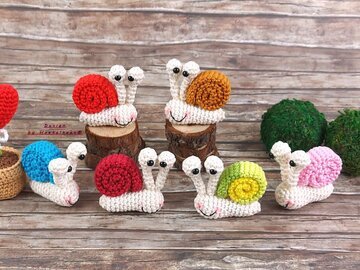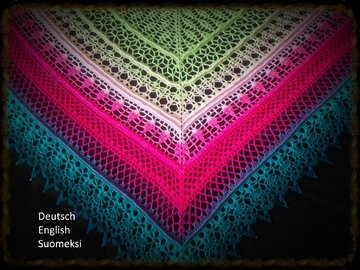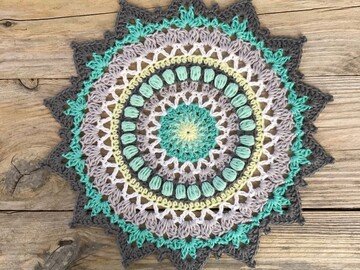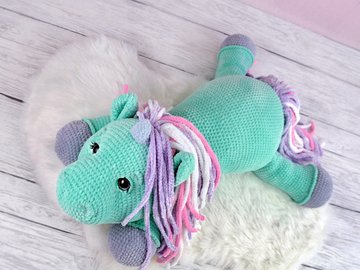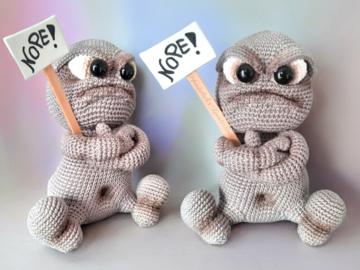Easter is approaching quickly, and you know how fast it goes—soon... Easter will be knocking at the door. Now is the perfect time to implement creative ideas for Easter! Why not tackle two charming projects? A crocheted carrot as an original packaging for Easter gifts and a cheerful garland with crocheted eggs and carrots will make your home ready for the celebration.
Do you actually know why carrots and Easter eggs fit so well with Easter?
Carrots and Easter eggs are not only beautiful motifs, but they also carry symbolic meanings that are closely tied to the Easter celebration. Carrots are a sign of spring and new life. They represent fertility and growth—central themes connected to the rebirth and resurrection that Easter represents. Additionally, carrots are often associated with the Easter Bunny, who is seen in many traditions as the bringer of Easter eggs.
Easter eggs are an ancient symbol of new life and resurrection. They signify spring and the return of nature after winter. The practice of dyeing and decorating eggs is a beloved tradition that brings joy and creativity to the Easter season. Eggs are also seen as symbols of hope and new beginnings—perfectly reflecting the central messages of Easter.
That’s why we thought you, like us, can’t get enough of them and should crochet a lot of them. So here are our latest patterns just in time for Easter:
Materials for your projects
To create both the carrot packaging and the garland, you will need:
.jpeg)
- Yarn:
- Bright orange and green for the carrot.
- For the gift carrot, I used chenille.
- For the mini carrots, it’s best to use cotton yarn, such as from wollidu.de.
- Various colors for the eggs, also cotton. I used Corona Kings Soft Print, as it has a marbled look, but white works well too if you want to add small accents, like little hearts or flowers.
- Crochet Hook: A suitable hook for the yarn thickness (sizes 3 and 6).
- Filling Material: For the mini carrots and the eggs.
- Ribbon or String: To close the carrot and for the garland.
The Crocheted Carrot: Original Packaging
.jpeg)
The crocheted carrot is not only a real eye-catcher but also a creative way to package small surprises and treats. Fill the carrot with chocolate eggs, homemade goodies, or small gifts, and close it with a pretty ribbon. This makes giving a gift a special experience!
And here's how to do it:
We start with orange yarn and in spiral rounds.
1. Round: Six single crochets in a magic ring.
.jpeg)
2. Round: Double every stitch (12)
3. Round: 12 single crochets (12)
4. Round: 12 single crochets (12)
.jpeg)
5. Round: Double every second stitch (18)
6. Round: 18 single crochets (18)
7. Round: 18 single crochets (18)
.jpeg)
8. Round: Double every third stitch (24)
9. Round: 24 single crochets (24)
10. Round: 24 single crochets (24)
.jpeg)
11. Round: Double every fourth stitch (30)
12. Round: 30 single crochets (30)
13. Round: 30 single crochets (30)
.jpeg)
14. Round: Crochet the 14th and 15th stitches together twice—this means decreasing two stitches in this round (28)
.jpeg)
15th-20th Rounds: 28 single crochets
.jpeg)
Then cut the yarn, pull it through, and secure the ends.
Next, switch to green yarn and crochet back and forth in rows.
.jpeg)
.jpeg)
1. Row: Insert the hook into the back loop of the last round in orange and crochet 14 single crochets, then make a turning chain.
.jpeg)
2. Row: 14 single crochets.
Cut the yarn, pull it through, and secure the ends.
Repeat Rows 1 and 2 in the front loop.
.jpeg)
.jpeg)
3. Row: Make a turning chain, insert the hook into both parts of each stitch, and crochet 14 single crochets (this will create a "tunnel" through which the ribbon will be threaded at the end).
.jpeg)
.jpeg)
4. Row: 14 single crochets.
5. Row: 14 single crochets.
.jpeg)
Repeat this on the other side, that is, on the other unworked orange stitches, and then thread the ribbon through.
.jpeg)
.jpeg)
The Garland of Eggs and Carrots: Cheerful Decoration
.jpeg)
You also need some decoration to bring those beautiful, colorful Easter hues into your home. And by the way, you can also hang the eggs and mini carrots on an Easter bouquet! 😉
And here's how to do it:
First, I will explain how to crochet the small eggs. We will be working in spiral rounds.
1. Round: Four single crochets in a magic ring (4)
.jpeg)
2. Round: Double every stitch (8)
.jpeg)
3. Round: Double every stitch (16)

4. Round: Double every second stitch (24)
.jpeg)
5. Round: Double every third stitch (32)
6. Round: 32 single crochets (32)
.jpeg)
7. Round: Crochet the 15th and 16th stitches together twice—this means decreasing two stitches in this round (30)
8. Round: Crochet the 9th and 10th stitches together three times—this means decreasing three stitches in this round (27)
.jpeg)
9th-12th Rounds: 27 single crochets (27)
13. Round: Crochet the 8th and 9th stitches together three times—this means decreasing three stitches in this round (24)
.jpeg)
14. Round: Crochet the 3rd and 4th stitches together six times—this means decreasing six stitches in this round (18)
.jpeg)
Now, stuff the egg with filling material to give it a nice shape.
15. Round: Crochet the 5th and 6th stitches together three times—this means decreasing three stitches in this round (15)
.jpeg)
16. Round: Crochet the 4th and 5th stitches together three times—this means decreasing three stitches in this round (12)
17. Round: Crochet the 2nd and 3rd stitches together four times—this means decreasing four stitches in this round (8)
.jpeg)
Cut the yarn and, while securing it, pull the last round’s stitches together tightly so that no hole remains.
And now we can tackle the mini carrots. These will also be crocheted in spiral rounds.
1. Round: Crochet six single crochets in a magic ring (6)
.jpeg)
2. Round: 6 single crochets (6)
3. Round: 6 single crochets (6)
.jpeg)
4. Round: Double every stitch (12)
5. Round: 12 single crochets (12)
6. Round: 12 single crochets (12)
.jpeg)
7. Round: Double every second stitch (18)
8. Round: 18 single crochets (18)
9. Round: 18 single crochets (18)
.jpeg)
10. Round: Double every third stitch (24)
11th-14th Rounds: 24 single crochets (24)
.jpeg)
15. Round: Crochet the 3rd and 4th stitches together six times—this means decreasing six stitches in this round (18)
.jpeg)
.jpeg)
Now, stuff the carrot with filling material—be careful not to pack it too tightly, as it will be easier to crochet the green directly onto it.
16. Round: Crochet the 2nd and 3rd stitches together six times—this means decreasing six stitches in this round (12)
.jpeg)
17. Round: The last rounds are a bit complicated for beginners; if you don’t have much experience, there is a simplified alternative below.
Always crochet two stitches together, working only in the back loop (the front loop will be used to attach the green directly) (6)
Cut the yarn and then continue crocheting with green.
.jpeg)
18. Round: Crochet one round in green, working into the remaining front loop and also crochet two stitches together (6)
.jpeg)
19. Round: Alternate between two single crochets in one stitch and two double crochets in the next stitch—repeat six times (12)
.jpeg)
.jpeg)
Cut the yarn and secure the ends.
Simpler Alternative for Beginners:
17. Round: Always crochet two stitches together, six times—this means decreasing six stitches in this round (6)
Cut the yarn and secure the ends.
With green, crochet a chain of six stitches and join it into a circle.
1. Round: One turning chain and six single crochets (6)
2. Round: Alternate between two single crochets in one stitch and two double crochets in the next stitch—repeat six times (12)
Cut the yarn and secure the ends—then sew it onto the carrot, and you’ll have everything beautifully connected!
We wish you a Happy Easter in advance!






























